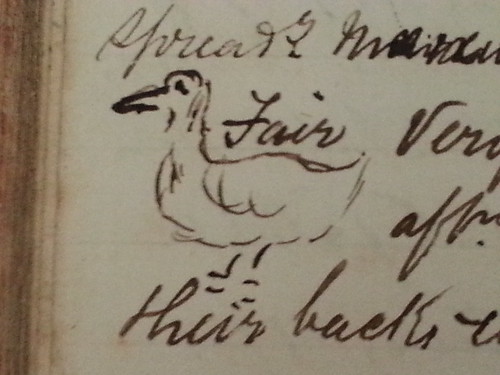My great great great uncle John Bayliff Bowman lived at Summer Hill, near Monyash in the County of Derby.
The Bowman family, who were Quakers, had three farms, One Ash Grange [which John Bayliff Bowman often referred to as O.A.], Cales and Summer Hill [which he usually referred to as S.Hill or S.H.]
The Bowman family, who were Quakers, had three farms, One Ash Grange [which John Bayliff Bowman often referred to as O.A.], Cales and Summer Hill [which he usually referred to as S.Hill or S.H.]
A Farm Journal continues :~
5 - 1d[ay] 10 Mo[nth] Fine but cold East winds Spread[in]g manure at Cales Self to Nott[ingha]m even[in]g
6 - 2 Very fine day Nott[ingha]m Fair* Very sharp frost here home in even[in]g
7 - 3 Misty morn[in]g wet aft[ernoo]n lead[in]g manure S.H. gave calves turpentine & salt their backs every week - give 36 sheep & 74 lambs on Rape some cake & corn now - sold Jas Critchlow 7 heifers at 7/6 p[e]r stone
1st - 4 Fine
2 - 5 Beautiful day lead[in]g manure S.H.
3 - 6 Very wet day Committee of Quarterly meet[in]g had a meeting at Monyash - viz - Thos Hartras Richd Thompson & wife G.Pickard John Armitage - very nice meeting
4 - 7 Fine day Shower in even[in]g Bakewell Farmers Club Show - very slender show
5 - 8 Fine day lead[in]g manure
6 - 9 Showery day harrow[in]g & spread[in]g manure
7 - 10 Fine & warm finish[e]d spread[in]g manure - calf with worm in throat at Cales - sold Thompson cow bo[ugh]t at Matlock £14 10/- only milked a little while £12 ! bad
1 - 11 Beautiful day - my dear S.A. was delivered of another fine boy all well **
2 - 12 Fine day Bakewell Fair busy but things low bo[ugh]t 6 sandy [sundry ?] pigs of Randall 45/-
3 - 13 Misty morn[in]g getting potatoes fair crop sold some at 12/- p[e]r load finish[e]d
* Rather than write 'Nottingham Goose Fair' John wrote 'Nottingham' and 'Fair' with the drawing of a goose in between [see above].
** The 'fine boy' born on the 11th October 1868 was presumably John Edward Bowman.
1st - 4 Fine
2 - 5 Beautiful day lead[in]g manure S.H.
3 - 6 Very wet day Committee of Quarterly meet[in]g had a meeting at Monyash - viz - Thos Hartras Richd Thompson & wife G.Pickard John Armitage - very nice meeting
4 - 7 Fine day Shower in even[in]g Bakewell Farmers Club Show - very slender show
5 - 8 Fine day lead[in]g manure
6 - 9 Showery day harrow[in]g & spread[in]g manure
7 - 10 Fine & warm finish[e]d spread[in]g manure - calf with worm in throat at Cales - sold Thompson cow bo[ugh]t at Matlock £14 10/- only milked a little while £12 ! bad
1 - 11 Beautiful day - my dear S.A. was delivered of another fine boy all well **
2 - 12 Fine day Bakewell Fair busy but things low bo[ugh]t 6 sandy [sundry ?] pigs of Randall 45/-
3 - 13 Misty morn[in]g getting potatoes fair crop sold some at 12/- p[e]r load finish[e]d
* Rather than write 'Nottingham Goose Fair' John wrote 'Nottingham' and 'Fair' with the drawing of a goose in between [see above].
** The 'fine boy' born on the 11th October 1868 was presumably John Edward Bowman.


Lovely touches of humanity within the everyday records ...
ReplyDeleteHe was a little more wordy this particular fortnight Pet.
DeleteI think it's the first time I saw a little drawing in this journal... it's a goose but not a wild one ;)
ReplyDeleteI think you're right. Even Wildgooses aren't always so wild ... :-)
DeleteThis comment has been removed by a blog administrator.
ReplyDeleteAnother interesting insight to farming in the 1800s, turpentine and salt is a new one,I wonder what it was for.There is a pig called the Oxford Sandy perhaps that was the sandy he mentioned.Ann
ReplyDeleteI had misread the statement "gave calves turpentine & salt their backs every week". I assume the turpentine was administered orally and the salt rubbed into their backs ... but why I don't know. Thanks for the info as regards the Oxford Sandy ~ it does look more like 'sandy' than 'sundry' in the journal. I hope you;re enjoying your break Ann ...
DeleteHubby thinks the turpentine and salt would be rubbed on their backs to kill the Warble Fly,there has been an eradication scheme so isn't a problem now.Yes had a great holiday thank you Charlie,visiting our son and family.Our 18mth old granddaughter understands Italian more than we do.Ann
ReplyDeleteThanks for that info Ann ... things have got better in some respects for farmers then :-)
DeleteGlad you had a good holiday. Isn't it amazing how children pick up languages ?